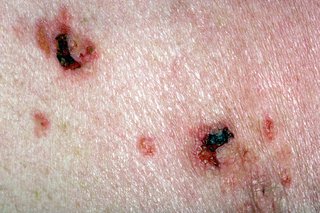Pemphigus vulgaris (PV) is a rare and serious (potentially life-threatening) condition that causes painful blisters to develop on the skin and lining of the mouth, nose, throat and genitals.
The blisters are fragile and can easily burst open, leaving areas of raw unhealed skin that are very painful and can put you at risk of infections.
There's currently no cure for pemphigus vulgaris, but treatment can help keep the symptoms under control.
The condition can affect people of all ages, including children, but most cases develop in older adults between the ages of 50 and 60. It isn't contagious and can't be passed from one person to another.
Symptoms of pemphigus vulgaris
The blisters usually develop in the mouth first, before affecting the skin a few weeks or months later.

Alamy Stock Photo
There may be times when the blisters are severe (flare-ups), followed by periods when they heal and fade (remission). It's impossible to predict when this might happen and how severe the flare-ups will be.
Blisters in the mouth often turn into painful sores, which can make eating, drinking and brushing teeth very difficult. The voice can become hoarse if the blisters spread to the voice box (larynx).
Sores on the skin can join together to form large areas of painful, raw-looking skin, before crusting over and forming scabs. They don't usually leave any scars, although affected skin can occasionally become permanently discoloured.
As well as getting blisters in the mouth, they can also develop in other areas of the digestive system's soft tissue lining, including the nose, throat, anus, genitals and vagina. The thin membrane that covers the front of the eye and inside of the eyelids (conjunctiva) can also be affected.
When to get medical advice
See your GP if you have severe or persistent blisters or sores in your mouth or on your skin.
It's unlikely you'll have pemphigus vulgaris, but it's a good idea to get your symptoms checked out.
If your GP thinks your symptoms could be caused by a serious condition such as pemphigus vulgaris, they may refer you to a dermatologist (skin specialist) for some tests.
The dermatologist will examine your skin and mouth, and may remove a small sample (biopsy) from the affected area so it can be analysed in a laboratory. This can confirm whether you have pemphigus vulgaris.
A blood test can also be used to check for antibodies (infection-fighting proteins) in your bloodstream, to help confirm the diagnosis.
What causes pemphigus vulgaris?
Pemphigus vulgaris is an autoimmune condition. This means that something goes wrong with the immune system (the body's defence against infection) and it starts attacking healthy tissue.
In pemphigus vulgaris, the immune system attacks cells found in a deep layer of skin, as well as cells found in the mucous membrane (the protective lining of the mouth, nostrils, throat, genitals and anus). This causes blisters to form in the affected tissue.
It's unclear what causes the immune system to go wrong in this way. Certain genes have been linked to an increased risk of pemphigus vulgaris, but it doesn't tend to run in families.
Treatments for pemphigus vulgaris
Pemphigus vulgaris is a long-term (chronic) condition that can't be cured.
However, the symptoms can often be controlled using a combination of medicines that help stop the immune system attacking the body.
Most people start by taking high doses of steroid medication (corticosteroids) for a few weeks or months. This helps stop new blisters forming and allows existing ones to heal.
To reduce the risk of side effects of steroids, the dose is gradually reduced and another medication that reduces the activity of the immune system is taken as well as the steroid.
It may eventually be possible to stop taking medications for pemphigus vulgaris if the symptoms don't come back, although many people need ongoing treatment to prevent flare-ups.
Read more about treating pemphigus vulgaris.
Risk of infected blisters
There's a high risk of blisters caused by pemphigus vulgaris becoming infected, so it's important to look out for signs of infection.
Signs of an infected blister can include:
- the skin becoming painful and hot
- yellow or green pus in the blisters
- red streaks leading away from the blisters
Don't ignore these signs – an infected blister could potentially lead to a very serious infection if left untreated. Contact your GP or dermatologist for advice straight away.
Help and support
Being told you have a rare, serious condition can be a confusing, frightening and sometimes lonely experience.
It can help to find out as much as you can about the condition and how best to cope with it.
A good place to start is the Pemphigus Vulgaris Network, a UK support group for people with pemphigus vulgaris.
NHS support is also available to help you deal with the physical and emotional effects of living with long-term pain.
Read more about living with pain.
Page last reviewed: 2 October 2018
Next review due: 2 October 2021
